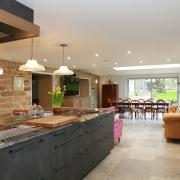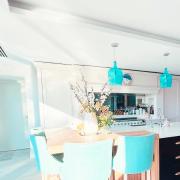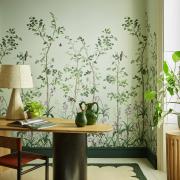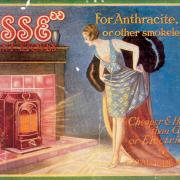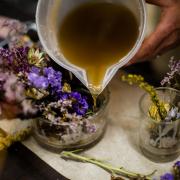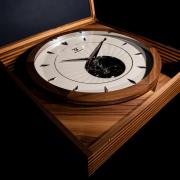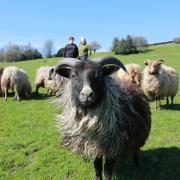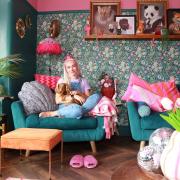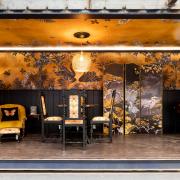One of Britain’s leading interior designers has turned a remote property into a designer dream home. Eileen Jones reports. PHOTOGRAPHY: KIRSTY THOMPSON
The expression ‘wow factor’ is so over-used that its impact has lost currency. And yet, walking into any room designed by Dorothy Wightman, and that is an instinctive response. Taken on a tour of her five-bedroomed converted farmhouse, visitors are either ‘wowed’ or speechless.
But before the tour begins, you need to reach your destination which involves a five minute drive down a narrow track where the Farleton fells smile seductively across to the dales, and where Lancashire rubs shoulders with Westmorland. This is where we meet Dorothy, at Aikbank, the holiday cottage she created from an old farmhouse,
It might be wise to sit down. Dorothy is one of those energetic women who seem to have more hours in their day, and more days in their week, than most. It can be quite exhausting to hear the matter-of-fact litany of her normal routine.
They breed them tough out here, of course, and Dorothy, one of Britain’s leading interior designers, is a local lass, born at Old Hutton, from farming stock. Husband Edward today farms the land around the family home and Dorothy’s showroom on the A65 near The Plough Inn at Lupton.
She trained as a confectioner in Kendal. ‘My father reckoned that no matter how hard up people were, they would always want food.’ She is a wonderful cook and baker, as holidaymakers and the sons – Derek and Jonty – will testify.
But Dorothy’s mother’s influence was stronger. ‘She was always sewing and knitting, and I was brought up with that. I had a real interest from being very young. And I was always re-arranging her ornaments.’ That was her training. ‘It’s something that you are born to be able to do. You can’t really learn it. If people want to work with me, I can tell in a very short space of time if they are right, if they have got it.’
She started small and the business grew, but it was by determined effort rather than lucky chance. ‘I used to feel guilty when the children were younger. I’d work during the day, come home, feed the boys, help with their homework, and then back to work again, often till 1am.’
Younger son Jonty adds: ‘It was really interesting to grow up learning about business.’ And sure enough, rather than go to university (Plan A), he set up Crabtree Clay Shoot, which is doing very well.
Dorothy’s reputation grew. She had a base at Yew Tree Barn at Low Newton before opening her own workshop and showroom 11 years ago, all the while designing and making her own soft furnishings and partnering them with the best from designer ranges around the world.
She now has a staff of ten, sewing and designing at the workshop, plus a team of joiners, painters and decorators who have been chosen because they understand her vision. She was also transforming the living spaces of people who appreciated her quirky view of interiors, refurbishing corporate-owned castles and boardrooms, privately owned mansions, alpine chalets and the homes of celebrities. ‘I’ve done work in Jersey, France, Miami, houses for foreign dignitaries, even beading for Russian clients,’ she recalls.
The result is not a ‘look’ that can be repeated. ‘We do everything from cutting edge right through to what you would put in a castle. It’s never the same result.’
And where better to illustrate what Dorothy means than in her own masterpiece of creativity, a converted farmhouse surrounded by sheep and lambs and hillsides and trees and very little else, a magnum opus which took four years to complete. Aikbank is stereotypically rustic on the outside; step inside and this is a palace of contemporary design.
The floors are oak, likewise the ten-seater table in the kitchen, with its Emma Bridgewater crockery, where the curtains, curiously, don’t match. ‘Why not? I did something similar for a funky young man from a famous boy band who wanted curtains that were different lengths.’ The effect is stunning; anywhere else it might look like odd mis-matching.
There’s another, round, ten-seater table in the dining room, this one made of dark wenge, whose chairs are covered in different fabrics, various shades of stripes, and a pattern called ‘housepets’ decorated with dogs and cats and fish. In the centre of the table is a giant, striped Missoni candle in an even larger glass vase.
The long, L-shaped sofa in the sitting room was made to fit the space, and is covered with cushions from different designers. There’s a separate TV lounge. On the walls are paintings by, largely, local artists: talented names such as Tracey Levine, Caron Threlfall, Angie Flynn and Marian Kuit. Aikbank is constantly evolving, and if visitors like a particular piece of artwork, or a lamp, they can buy it.
Upstairs (the handrail, please note, was made by a local blacksmith) are five bedrooms, each with individually designed and built furniture. In one, a wardrobe door slides along to reveal a huge TV. Bedcovers and curtains are from a number of top designers, including Missoni and Jim Thompson and Travis, though all the bedlinen is from Dorothy’s own range. ‘It’s really soft.’ Indeed, it felt silky. ‘It’s like sleeping on dogs’ ears.’
Two rooms have curious Timorous Beasties lampshades. In another, the wall bears a print which is actually a Manolo Blahnik scarf, a gift from a client. ‘It’s all about impact,’ Dorothy says.
Though the house can accommodate ten comfortably, it is sometimes rented by just two, appreciative of the cosiness. However many, Dorothy spoils them. One wrote: ‘You have made it very difficult to stay anywhere else and not be disappointed.’
So Dorothy can now, at last, relax a little, concentrate on the showroom, indulge her passion for gardening. But next to Aikbank are several barns and out-buildings, just crying out for re-development. The result, it’s certain, will be just as quirky and individual.




